Training Hitting for Rapid Improvement
The Mental Approach to Hitting Series
Baseball and Fastpitch Softball
This Training Hitting Scientifically article is excerpted from our new drills book, The Ultimate Hitting Training Guide (click for over 140 functional drills containing 500 step-by-step mini-goals).
How to conduct hitting training? Is it asking the hitter to change specific body positions (stay back, keep head in) during coach pitch BP? Or is it allowing hitters to broadly do their best to “feel” their way to success via thousands of mindless repetitions? Unfortunately, neither of these methods can be counted on for training hitting most efficiently.
It is possible to dramatically shorten the learning curve, establishing the hitter as one of the best on their team.
To accomplish this objective, we offer two compelling concepts for training hitting scientifically.
Table of Contents
Two Motor Cognition Scientific Concepts
Modern science can be applied to improve methods for training athletes; upcoming, we name and describe two concepts derived from the science of motor cognition. Applying the following motor cognition concepts substantially speeds the learning curve of the developing hitter.
- Theory of Perception-Action Coupling.
- Self-Organizing Movements.
Perception-Action (PA) Coupling for Training Hitting
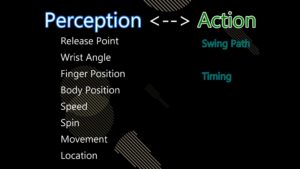
The theory of Perception-Action Coupling has important implications for identifying the most effective method of training hitting.
Performing a movement leaves behind a bidirectional association between the motor pattern and the sensory effects that it produces.
The theory of Perception-Action (PA) Coupling argues that perception and action processes are functionally intertwined. When PA Coupling occurs, there is no thinking or deliberate decisions made. Much like a computer algorithm, the environment is perceived (see image on the previous page), then the physical action is subconsciously initiated based on the perception. PA Coupling is especially relevant when training hitters to recognize pitch types at release and react appropriately. It also highlights the need for routine game-like hitting practice.
As the hitter’s eyes scan the environment, their brain builds a picture of the task ahead and tries to call upon appropriate movement patterns and strategies that could fit that task. The hitter’s brain is subconsciously visualizing ball flight, firing the neurons relating to that ball flight, and, ideally, responding with the movement pattern pertaining to the most productive timing and swing path.
Batters get better with game-like practice because their subconscious minds can recall previous situations in which the ball was released similarly and with the same trajectory. They are better able to react with a more appropriate movement response based on past successes and failures. Utilizing both block (same pitch) and variable (mixed pitches) practice of fastballs, change-ups, curves, etc., improves the hitter’s ability to have a stored, successful, and myelinated motor programs and enhances the efficiency and speed to which these programs are accessed.
Game-Like Pitching is Best for Training Hitting
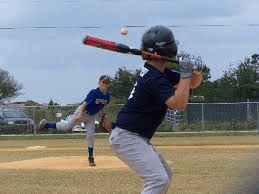
Lay off the high pitch.
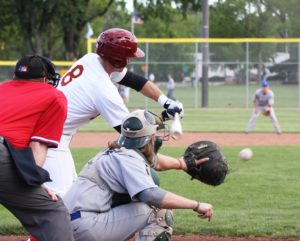
Successful check swing on slider off the corner.
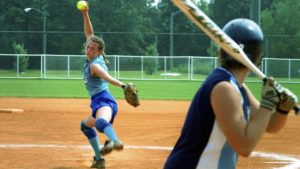
Here comes the change!
According to the PA Coupling theory, to be most effective, live pitching must be competitive. The pitcher must strive to strike out the batter using off-speed, movement, and off-plate “chase” pitches. Crucially, establishing a game-like environment adds variables the hitter must adjust for. Numerous repetitions of the following variables are not present in the typical hitting workout:
- The hitter can hone abilities to check swing on breaking pitches, which just miss.
- The hitter can strive to get their swing on the plane with a dropping or laterally moving pitch.
- The hitter can practice recognizing and adjusting timing for the off-speed pitch.
Of course, the downside is this type of practice relies on available live arms. And a catcher in gear. And someone is calling pitches. It is time-consuming. Significantly, depending on the pitchers’ ability, scrimmages can result in a hitting practice with few quality reps. But, if the theory of PA Coupling is true, we as coaches should allocate more time for hitting competitive pitching. The results may well be worth the effort!
Use the Self-Organizing Tool for Training Hitting
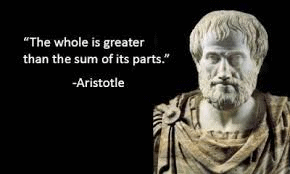
Science supports that the intention of the movement is the first thing processed by the brain. Read that again!
In other words, the hitter consciously visualizes the movement pattern required to hit the ball to their target. Maybe the target is a line drive into the outfield. The hitter allows self-organization to derive the optimal body movements to hit the target. Purely by setting an appropriate task, the hitter can allow the body to self-organize in a way conducive to completing the task.
When asking the hitter to self-organize, the coach should not set any limits on freedom of movement – coaching commands or cues cause massive disruption to the hitter’s ability to self-organize.
The development of specific productive hitting techniques can be self-organized given the right:
- Environment.
- Equipment.
- Experimentation.
- Physical capabilities.
- Concepts.
- Focus/Awareness.
- Amount and quality of practice.
- Parameters.
The discussion of how each of these variables can be adjusted is beyond the scope of this article (click The Ultimate Hitting Training Guide to learn more about our new drills book utilizing constraints). But stay tuned; in the next section, we dive a little deeper into how to use the self-organizing movements tool.
How to Allow Technique to Self-Organize
To a surprising extent, the hitter can train techniques without thought awareness or being taught specific mechanics. This can be done by:
- Encouraging experimentation with different variables (see list above).
Let the hitter can utilize their body’s instinctive intelligence. They will refine the combination of movements that work best for them. The cool part is, this refining happens subconsciously, increasing long-term retention.
Example – Training Hitting Scientifically
Training hitting scientifically often entails a mixture of internal focus, targeting (external result focus), and self-organizing movements. Here is an example of how to use this mixture of attention focuses to best train a hitting skill.
In this case study, we want the hitter to improve their ability to hit the low (at the knees) middle of the plate pitch location. The goal is to hit this pitch location for the highest possible rate of base hits and slugging percentage – swing path is key to increasing the rate of hard-hit line drives to the middle of the field.
- In step 1, the hitter strives to hit the ball in the middle of the field (not pulled!). This requires staying inside with their hands and barrel and not get around the ball.
- In step 2, we desire the hitter to hit consistent line drives. The hitter must swing with a slightly positive attack angle matching the incoming plane of the pitch (click the link to view our free article describing how to swing in-plane).
Whew! If we tried to train this skill solely by internal thinking, that is, by physically adjusting each specific movement and position, it would likely be a long project. Let’s see what happens when we incorporate targeting and self-organization into the hitter’s training in the upcoming steps.
Step 1 – Hit the Ball Up the Middle
Place a batting tee set for a knee-high (low) pitch in the middle plate location. Put a net 30 feet directly in front of the hitter. Ask the hitter to hit the ball into the net.
Most inexperienced hitters are around the ball, pulling the hit. So, to begin with, typically, very few hits go into the net. The hitter must learn to feel the barrel inside the path of the ball until contact. Additionally, they must learn to feel how hands must stay tight to the body as the swing starts. Ask the hitter to swing slowly, utilizing an internal focus. The hitter should try to hug hands to the body as the bat approaches contact. Then, try to move their arms so hands extend to the middle of the field after contact. Coach the hitter just a little until they begin to feel what needs to be done. Then stop coaching.
Now, to speed up learning, use self-organizing movements. The hitter should externally focus on the path of the barrel and on the target (net) of the hit ball. They should let their movements automatically adjust to accomplish the task of hitting the ball into the net. Their focus is primarily on the target. If needed, they can slow down and watch where the barrel is going. Continued to let the hitter practice targeting in this manner until the ball is going into the net consistently.
Step 2 – Get the Ball in the Air
The next step is to hit line drives into the outfield. Still, use the tee set to the low-middle pitch location. A productive target for most youth hitters is a line drive just over a six-foot-high net placed about 30 feet directly in front of the batter.
Click on our free article Optimizing Launch Angle for how to adjust launch angle based on experience, strength, and the type of hitter.

Use Internal Focus to Help Feel the Solution
Again, the hitter should swing slowly at first. They should observe the path of the barrel at contact. Is the barrel moving down to the ball (negative attack angle) or slightly up through the ball (positive attack angle)?
If it is down to the ball, ask the hitter to try and feel what it will take to swing on a slightly upward path to contact.
As in the previous step, the hitter may need a moment of internal focus to help them feel the solution. To get the ball in the air, ask the hitter to keep their head centered between their feet as they swing. Then, ask them to get more athletic by pointing their nose at the dirt. Let the hitter feel this position – staying back with an increased spine angle.
Now, re-check the barrel path to see if it is slightly up at contact.
Then Switch to Targeting and Self-Organizing Movements
After a short period of focusing on specific movements, resume an external result focus on hitting the ball over the target. This is the point where most hitters start to successfully self-organize their movements. They begin to feel what it takes to hit a productive line drive into the outfield.
Allowing the hitter to self-organize movements results in more rapid improvement and improved retention of skills. Besides, targeting is more fun than focusing and controlling each specific body movement.
With good concepts, baseball and fastpitch softball players can become low-ball sluggers!
Final Thoughts for Hitting Training
Hitters are often surprised at how much their fundamentals improve without ever directly working on individual mechanics. The hitter can make improvements in the kinematic sequence, in the swing plane, in weight shift patterns, etc. They can do this without ever directly thinking about body positions.
The best progress is made when developing hitters balance self-organizing and directly (internally) learned techniques. This is where coaching comes into play to guide the hitter – the objective is to find the best mix of attention focuses for making productive swing adjustments efficiently and effectively.
While maybe not specifically named or defined, these motor cognition concepts have been applied in other sports for many years. And in baseball and fastpitch softball by some of the best coaches in the country.
Understanding how the brain regulates human movement speeds up the learning curve for athletes of all ages. And it makes practice more fun!
Building Rome Series Blog: The Mental Approach to Hitting Series
Click the links below for more free articles in The Mental Approach to Hitting Series:
Train Brain for Better Hitting
Eight Steps to a Productive Plan at the Plate
When and How to Look for a Pitch
How to Improve Seeing the Ball
The Magic of Mental Focus for Hitters
Building Rome Series Books: Building the High-Level Swing Series
 Click Building the High-Level Swing Series to learn more about our new two-book hitting series containing a detailed and comprehensive description of 100 hitting fundamentals and 140 step-by-step drills that efficiently construct the batting swing from the ground up.
Click Building the High-Level Swing Series to learn more about our new two-book hitting series containing a detailed and comprehensive description of 100 hitting fundamentals and 140 step-by-step drills that efficiently construct the batting swing from the ground up.
In the Building Rome Series of books, the construction of skills are in functional order, providing a “roadmap” to becoming a great hitter.
All baseball and fastpitch softball players can “climb the Roman Coliseum step-by-step” to become a powerful and productive hitter.
Enjoy the quest!
We appreciate your thoughts! Submit a comment (no email required) or send us any question using our contact page and we will get right back to you. All the best – Gary.